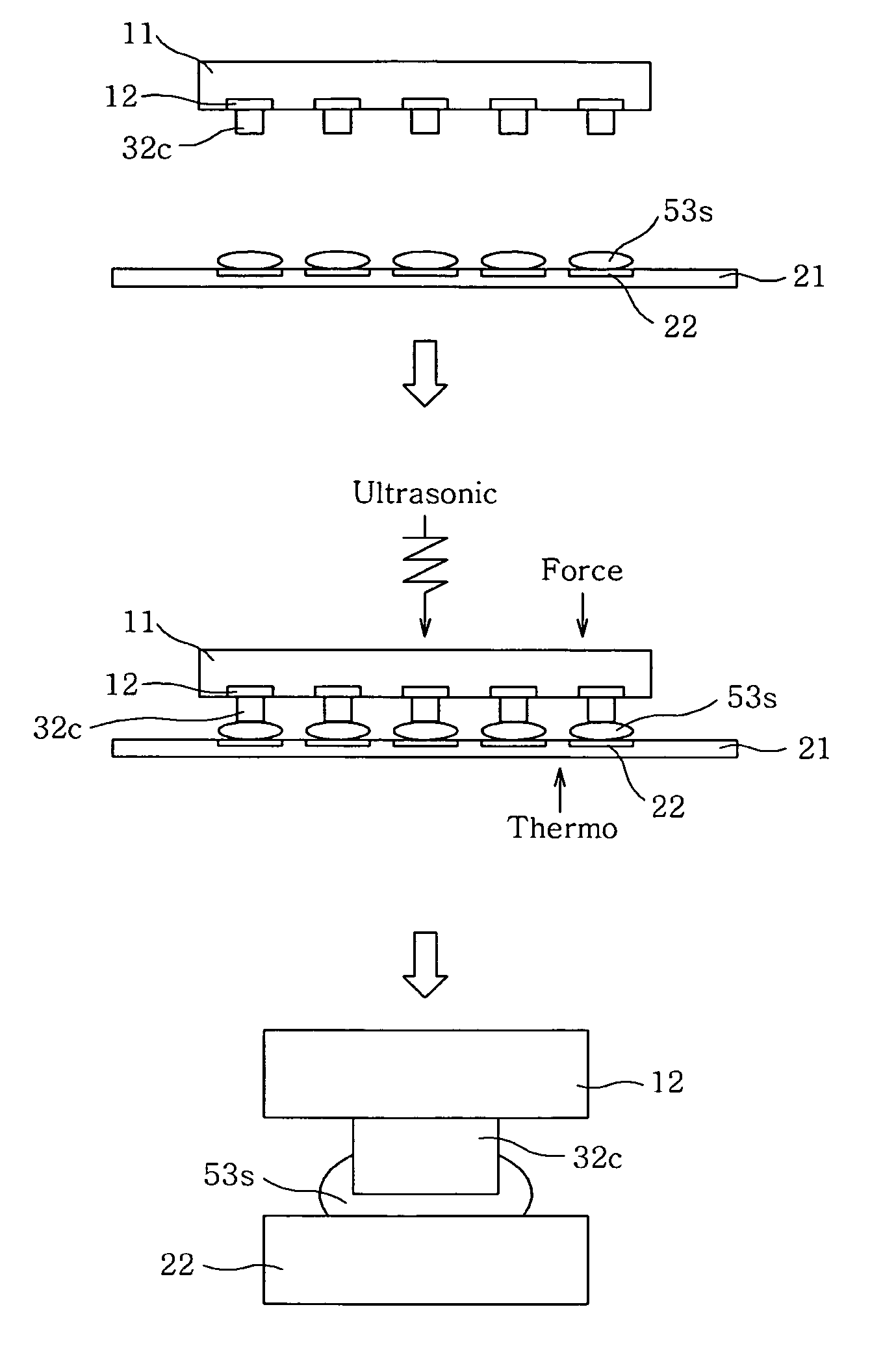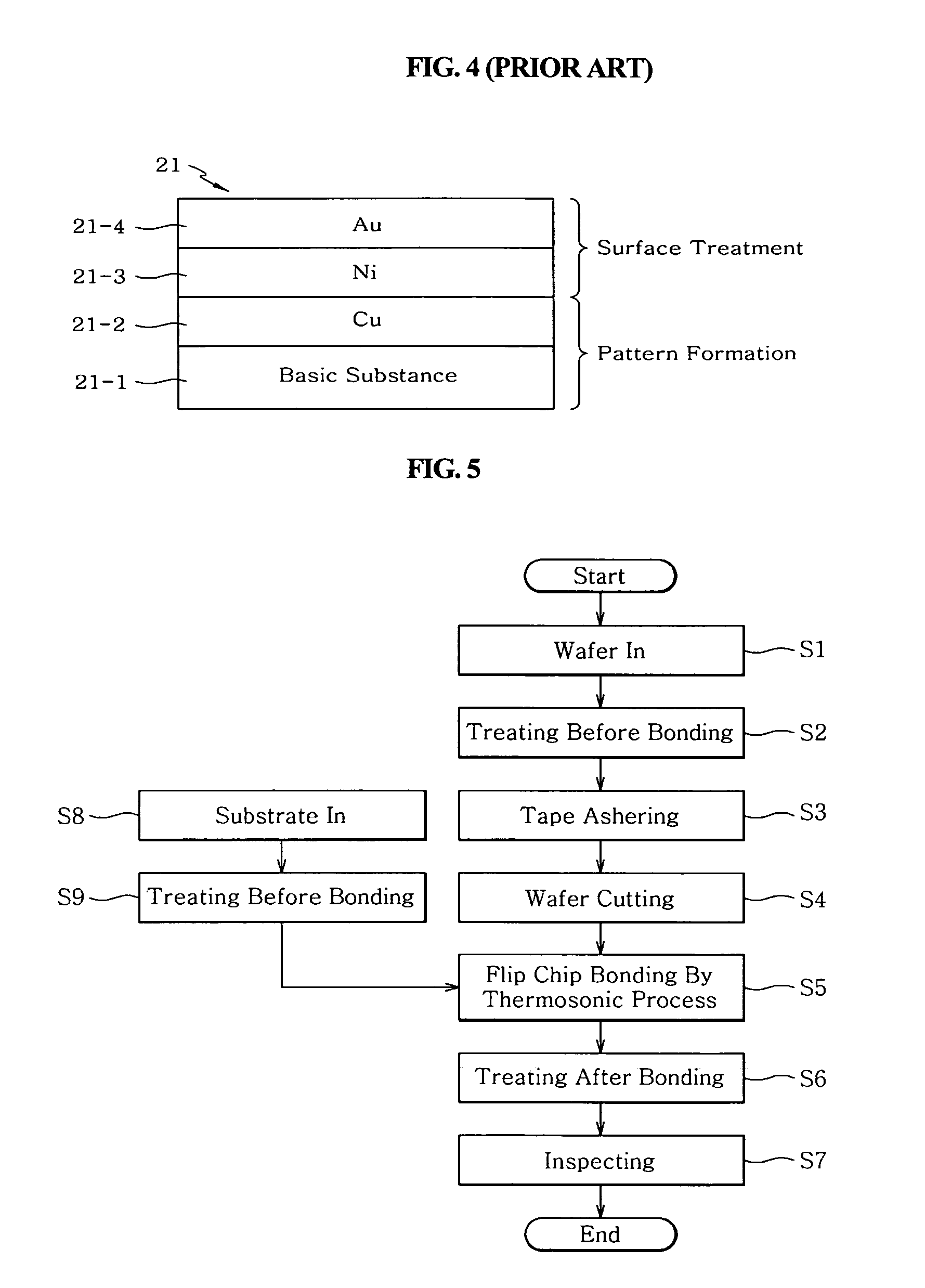Flip chip bonding method for enhancing adhesion force in flip chip packaging process and metal layer-built structure of substrate for the same
a technology of flip chip and bonding method, which is applied in the direction of coating, basic electric elements, chemical vapor deposition coating, etc., can solve the problems of chip damage, slow process rate, and limit of conventional wire bonding process for bonding semiconductor chips on the substrate, so as to improve bonding performance, speed up process rate, and improve reliability and productivity
- Summary
- Abstract
- Description
- Claims
- Application Information
AI Technical Summary
Benefits of technology
Problems solved by technology
Method used
Image
Examples
example 1
[0066]FIG. 29 is a view showing the process for a flip chip bonding between a substrate that is formed with a stud bump and a chip that is formed with a plated bump using a thermosonic method according to the invention.
[0067]Referring to FIG. 29, an aluminum bonding pad 12 of a chip 11 is formed with a plated bump 32c that is made of Au, Al, or Ni coated with Au. A lead pad 22 of a substrate 21 is formed with a stud bump 53s that is made of Au or Cu. In the flip chip bonding process S5, after the chip 11 and the substrate 21 are closely contacted, heat is applied to the substrate 21, and an ultrasonic wave of 70 KHz or more is applied to the chip 11 through a collet 95. Simultaneously, pressure is applied to the substrate 21. As a result, the plated bump 32c of the chip and the stud bump 53s of the substrate are bonded by energy generated from the heat, the ultrasonic wave and the pressure. Here, the collet 95 that is made of Zr, Ti, ceramic, stainless alloy, TiW alloy, TiC, and the...
example 2
[0068]FIG. 30 is a view showing the process for a flip chip bonding between a bare substrate and a chip that is formed with a plated bump u sing a thermosonic method according to the invention.
[0069]Referring to FIG. 30, an aluminum bonding pad 12 of a chip 11 is formed with a plated bump 32c that is made of Au, Al, or Ni coated with Au. A lead pad 22 of a substrate 21 is bare of any bump. In the flip chip bonding process S5, after the chip 11 and the substrate 21 are closely contacted, heat is applied to the substrate 21, and an ultrasonic wave is applied to the chip 11 through a collet 95. Simultaneously, pressure is applied to the substrate 21. As a result, the plated bump 32c of the chip and the lead pad 22 of the substrate are bonded by energy generated from the heat, the ultrasonic wave and the pressure.
example 3
[0070]FIG. 31 is a view showing the process for a flip chip bonding between a substrate that is formed with a stud bump and a chip that is formed with a plated bump and a stud bump formed on the plated bump using a thermosonic method according to the invention.
[0071]Referring to FIG. 31, an aluminum bonding pad 12 of a chip 11 is formed with a plated bump 32c that is made of Au, Al, Ag, Cu or Ni coated with Au. A stud bump 53c is again formed on the plated bump 32c. A lead pad 22 of a substrate 21 is formed with a stud bump 53s. In the flip chip bonding process S5, after the chip 11 and the substrate 21 are closely contacted, heat is applied to the substrate 21, and an ultrasonic wave of 70 KHz or more is applied to the chip 11 through a collet 95. Simultaneously, pressure is applied to the substrate 21. As a result, the stud bump 53c of the chip 11 and the stud bump 53s of the substrate are bonded by energy generated from the heat, the ultrasonic wave of 70 KHz or more and the pres...
PUM
| Property | Measurement | Unit |
|---|---|---|
| thickness | aaaaa | aaaaa |
| thickness | aaaaa | aaaaa |
| pressure | aaaaa | aaaaa |
Abstract
Description
Claims
Application Information
 Login to View More
Login to View More - R&D
- Intellectual Property
- Life Sciences
- Materials
- Tech Scout
- Unparalleled Data Quality
- Higher Quality Content
- 60% Fewer Hallucinations
Browse by: Latest US Patents, China's latest patents, Technical Efficacy Thesaurus, Application Domain, Technology Topic, Popular Technical Reports.
© 2025 PatSnap. All rights reserved.Legal|Privacy policy|Modern Slavery Act Transparency Statement|Sitemap|About US| Contact US: help@patsnap.com



